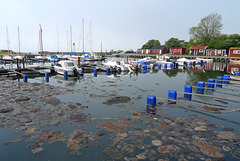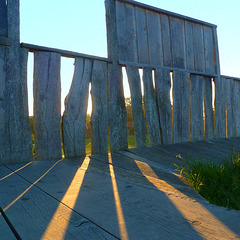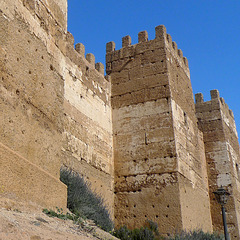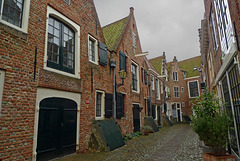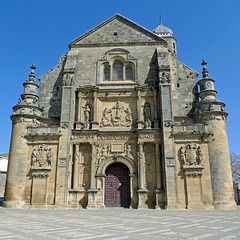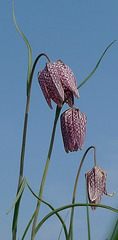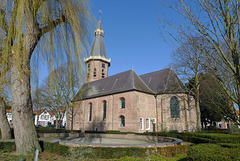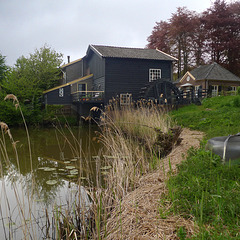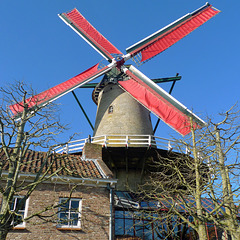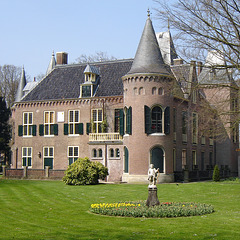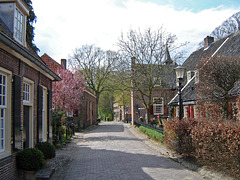Jaap van 't Veen's photos
Sweden - Smygehuk, harbour
| |
|
|
|
The area around the little harbour of Smygehuk has been inhabited for a long time. The small fishing hamlet has existed here since the 17th century. The harbour, built in the 1920's, was originally a limestone quarry. The small 'falu red' houses are huts where fishermen keep their nets.
Nearbij the harbour one can find a coign af vantage that marks Sweden's southernmost point.
Smygehuk's lighthouse (see note in the main picture), built in 1883, ia a 17 m high cast iron tower.
Sweden - Trelleborg, Trelleborgen Fortress
| |
|
|
|
In 1988 traces of a fortress complex were found at the highest point of the city of Trelleborg. It turned out this wall belonged to a wooden ring fortress from the Viking Age. The fortress was built in the 980’s - most probably on orders from Harald Bluetooth, by that time king of Denmark.
The Trelleborgen as it exists nowadays is a reconstruction from 1995, based on the archaeological finds, crafts traditions and educated guesses. The reconstructed quarter of the fortress lies in the middle of the city.
The complex offers also a Vikingmuseum, a souvenir shop and a café.
Spain - Baños de la Encina, Castillo de Burgalimar
| |
|
|
|
The castle in Baños de la Encina has several names: Castillo de Burgalimar, Castillo de Baños de la Encina, Castillo de Bury Al-Hammam, which is derived from the Arabic Al-Hammam Bury, which means "castle of the baths”. The castle, located on a top of a hill above Baños de la Encina is the most important monument in the city.
The construction of Castillo de Burgalimar started in the year of 967 by Caliph Al-Hakam II, as described by a plaque next to the entrance. Originally it was a mighty military fortress in the foothills of the Sierra Morena. It was given over through a treaty by the Muslims to the Christians in 1225. After that it was used continually - by several different ‘owners’ - until the middle of the 17th century. The site was redundant until 1850 when it was used as the city cemetery. This practice continued until 1928; three years later the castle was declared a national monument.
The Bury Al-Hammam castle is one of the best preserved Moorish castles in Spain. The medium-sized stone building has an elliptical design and is surrounded by an impressive wall with fifteen towers and parapets.
The Baños de la Encina Castle is also known as the ‘fortress of the seven kings’, due to the number of monarchs who lived here, including Ferdinand the Catholic.
Nederland - Blokzijl, De Wieden
| |
|
|
|
‘De Wieden’ is a large marsh wetland in the northwest of the province of Overijssel. This part of the National Park ‘Weerribben-Wieden’ is managed by the Dutch nature reserve organisation ’Natuurmonumenten’.
‘Wieden’ are man-made lakes by the excavation of peat. If one doesn't touch marsh wetland (swamp), it will gradually transform into land again. In order to maintain variety in the area’Natuurmonumenten regularly digs new holes, just like the peat diggers used to do. Nowadays ‘De Wieden’ is one of the most important lowland peat wetlands of Western Europe.
Nederland - Schin op Geul, Kasteel Schaloen
| |
|
|
|
Castle Schaloen - also named Chaloen - was first mentioned in 1375. It was owned by the knights Johan Struver van Hoelsbergh (or Hulsberg) and Geraerdt Mulaerdt. The last one became the full owner and the castle stayed within his family for the next one and a half century.
During the Eighty Years' War (late 16th century) Schaloen was occupied by Lodewijk van Nassau, but a year later it was destroyed by Spanish troops. The ruined castle came in the hands of Johan Reinier Hoen van Cartiels, who rebuilt it in 1656, using local marl.
Through marriage the castle came in possession of the De Villers Masbourg-family. Famous Dutch architect Pierre Cuypers was in charge of the restoration (1894) of the castle in a neo-Gothic style. The last owner of noble descent, a countess, left the castle in 1934.
The castle has been used as a school, but nowadays it is a private house. The bailey and gate house are housing a restaurant and hotel. The buildings are surrounded by a moat.
Nederland - Zuiderwoude, Kerkbrug
| |
|
|
|
Drawbridge in the village of Zuiderwoude; a small settlement with about 300 inhabitants, which is located less than 10 km’s from Amsterdam. The wooden bridge, over a stream called ‘Zwet’, dates back to the Middle Ages and was restored in 1983.
Nederland - Terwolde, ‘De Ooievaar’
| |
|
|
|
The current mill is the third one at this place. The first mill was a so called ‘grondzeiler’ with wings which came about two feet above the ground. The mill was built in 1854.by Abraham Ledeboer. Five years later the mill was sold to family Dieperink.
In 1896 the original mill was destroyed by fire. The second mill was a thatched stage mill and was used by the same family till the year of 1948, when it was bought by family Vorderman, well known millers in the region. In 1967, still in operation, the mill was restored for the first time.
Four years later the mill was destroyed again by fire. A local foundation took the initiative for rebuilding the windmill in Terwolde, 100 meters to the west of the old mill site. For the reconstruction the octagonal buck from the ‘Holtermansmolen’ from Deventer (most probably built in 1640 as a polder mill) was used.
In 1990 the reconstruction of ‘De Ooievaar’ (the Stork) was completed . Since then it houses one of the seven remaining operational flour mills in the Netherlands. But on 31 August 2015 the mill burned down again. Eearly May 2018- after the reconstruction - 'De Ooievaar' was opened to the public again.
Nederland - Middelburg, Kuiperspoort
| |
|
|
|
Middelburg, capital of the province of Zeeland, was one of the three fortified towns on the former island Walcheren. It is dating back to the 9th century and still steeped in culture and historic allure.
Middelburg took advantage of its proximity to the sea and became - after Amsterdam - the second most important trading center in the Dutch Republic during the Golden Age.
The 'Kuiperspoort' - hidden gem in the center of the city - is named after the 'Kuipersgilde' (Coopers' Guild), who resided there in the 17th century. This alley is one of the most charming places in Middelburg.
The alleyway shows traditional brick warehouses, step-gabled roofs and beautiful restored buildings dating to the 16th century. Its close proximity to the harbour was convenient during the Golden Age, when the barrels that were made there had to be rolled toward the ships. The narrow path in the middle of the cobblestoned street still can be seen.
Nederland - Voorst, Kasteel Nijenbeek
| |
|
|
|
Castle Nijenbeek was first mentioned in 1266, but most probably it was built around the year 1230 as a wooden keep, soon expanded into a stone castle and a fortified baily. First owner was Theodericus (Dirk), Lord of Nijenbeek. Its location on the banks of the river IJssel was very strategic, assuring control over the traffic on the river.
Early 16th century Castle Nijenbeek lost its strategic importance and the Gelrian Duke Karel van Egmond sold the castle. Shortly after 1533 it was adjusted for permanent habitation. During the Eighty Years' War Nijenbeek was considerably damaged due to a Spanish siege in 1585 and a siege by the Dutch troops a year later.
In 1672 the castle was used as headquarters by the State troops under the leadership of Johan Maurits van Nassau. The troops were supposed to prevent a French invasion over the IJssel. However the French occupied the entire region. Castle Nijenbeek, opposed to other castles, wasn't destroyed.
In the middle of the 18th century and in the following centuries the castle underwent several renovations. In 1945 the whole castle was shelled by Canadian troops because it was used by the German troops as a lookout post.
Despite emergency repairs, the roof finally caved in and the elements have taken their toll. All that remains of Castle Nijenbeek is a ruin that only can be viewed from a distance.
Nowadays (early 2014) there is a new plan to consolidate the present situation preventing a totally collapse of Nijenbeek,
Picture: the castle standing in the flooded floodplains of the river IJssel.
Spain - Úbeda, Capilla del Salvador
| |
|
|
|
Úbeda became more and more important during Moorish rule. The town was by Abd ar-Rahman II (822–852), who called it Medinat-Ubbadat Al-Arab (which means Úbeda of the Moors). The town was captured from the Moors in 1233 by King Fernado III.
Úbeda (and neighboring city of Baeza) benefited from extensive patronage in the early 16th century, resulting in the construction of a series of Renaissance style palaces and churches. In 2003, UNESCO declared the historic cores and monuments a World Heritage Site.
Although the ‘Sacra Capilla del Salvador del Mundo’ (Sacred Chapel of the Saviour)looks like a church, the building is a funerary monument and was created to be used as mausoleum of local nobility (nowadays there are religious services). Both interior and exterior are richly decorated; the main façade (picture) with relief work and statues. The building is considered to be one of the finest examples of Andalucian architecture from te Renaisance period.
Construction of the chapel started in 1536 by the architect Diego de Siloé; a second phase, four years later, was directed by Andrés de Vandelvira. In 1559 it was consecrated.
Nederland - Hasselt, kievitsbloem
| |
|
|
|
In the Netherlands the ‘kievitsbloem’ (snake’s head) is a very rare flower, which is even legally protected. Most of them - about 80% - can be found around the city of Hasselt in the province of Overijssel
Sometimes there are many flowering together and people call it the natural bulb fields of the Netherlands. It is commonly found growing in grasslands in damp soils and river meadows along the rivers ‘de Vecht’ and ‘Zwarte Water’.
Snake’s Heads are flowering from mid April till early May.
It has a couple of names, like Snake’s Head Fritillary, Checkered Daffodil, Chess Flower and Leper Lily (in the Netherlands ‘kievitsbloem’).
Pictures were taken in a small nature reserve, called ‘De Brommerd’ (see PiP).
Nederland - Groede, Grote Kerk
| |
|
|
|
The ‘Grote Kerk’ (Big Church) in Groede was built mid 13th century and belongs to the Flemish Hall Churches. The dating and architecture of the building refers to the former unity of Zeelandic and Flemish Flanders. From the beginning of the 14th century many of this kind of churches were built along the Flemish coast. The church in Groede has a remarkable octagonal tower.
Because Groede was flooded from 1583-1613 the church suffered a lot. In 1619 the choir was restored and further recovery followed from about ten years later. From 1618 the south aisle served almost two centuries as Walloon church; around 1685 this part of the church was separated from the rest.
In 1868 the ‘Grote Kerk’ was substantially rebuilt and completely plastered on the outside. During World War II Groede was spared from bombardments as it became a ‘red cross village’ by painting a huge red cross on the tower of the church.
In 1970 the church was completely restored and plaster was removed. The building fell into a very bad condition and in 2010 a new restoration was necessary. Since then the name of the church has been changed into ‘Grote Kerk’. Nowadays it is used again for services, but also for art exhibitions and other events.
Nederland - Laag-Keppel, watermolen
| |
|
|
|
Laag-Keppel became city rights as ‘Keppel’ in the year of 1404. With about 500 inhabitants is one of the smallest cities in the Netherlands. Laag-Keppel is located in the so called Achterhoek on the river Oude IJssel between Doetinchem and Doesburg.
Since the 14th century Laag-Keppel has a watermill. The current mill was built in the 19th century and until 1945 it was in operation. From that year an electric motor was driving the grinder due to a lack of water. In 1968 a plan was made to grind the mill on its original way by hydropower. Therefore a small windmill - a so called ‘spinnenkopmolen’ - was transferred from the province of Friesland with the intention of lowering the water level in the mill pond. Although it doesn’t work properly, it offers a unique watermill-windmill combination in a very peaceful setting.
Main picture: watermill
PiP: windmill with mill pond
For more info about the mills (Dutch): keppelsemolens.nl
Nederland - Sluis, ‘De Brak’
| |
|
|
|
In the Middle Ages Sluis - a walled city - had a dozen mills. The only remaining windmill is‘De Brak’, named after a French breed 'Braque', a hunting dog always running with his nose in the wind.
The mill was built in 1739 and was the first in the region made of stone. The upper part of the smock mill can be put into the direction of the wind, which is called ‘kruien’ by the miller. From the stage one has a magnificent view over the city, the ramparts and further afield.
During World War II ‘De Brak’ was severely damaged; in 1950 began the reconstruction. The mill is now working as ever and is still used for grinding grain, which can be purchased in the mill store. ‘De Brak’ - located in the heart of Sluis - can be visited.
More info (Dutch): www.molendatabase.nl/nederland/molen.php?nummer=917
Nederland - Lisse, Kasteel Keukenhof
| |
|
|
|
Castle Keukenhof (as the famous garden) has a rich history. The area was part of Teylingen Castle, where during the 15th century game was hunted and food collected in the woods and dunes for the kitchen of the castle (‘Keukenhof’ got its name, which means ‘kitchen courtyard’ in Dutch).
The castle was constructed in 1642 by Adriaen Maertenszoon Block, a former Commander of the V.O.C. (United East Indian Company) and is connected to the success of Holland’s Golden Age. The house was initially intended as a country retreat, where the family could spend the summer months.
Block slowly expanded the property and even became the biggest landowner in the area. In the following centuries the estate kept growing. Castle Keukenhof is one of the few surviving country estates on Hollands west coast.
In the mid-19th century a rich noble family from The Hague bought the estate and transformed the house into 'the castle' in its present condition.
Castle Keukenhof is located across the entrance of the world famous Keukenhof, garden and flower exposition.
Spain - Baeza, Plaza del Pópulo
| |
|
|
|
The Plaza del Pópulo is the most beautiful square of Baeza; it is also known as Plaza de los Leones , referring to the fountain of the same name. The square is surrounded by impressive buildings dating back to the heyday of Baeza. The name Plaza de Pópulo refers to the Virgen del Pópulo, the patron saint of the city .
La Antigua Carnicería dates from the 16th century. This old butchers shop (Antigua Carniceria) stood about 100 metres from its present spot and was moved stone by stone to the Plaza de los Leones. The façade on the upper floor shows the coat of arms of Emperor Carlos V, a double-headed eagle.
The building has been used as municipal slaughter house until late in the20th century, but nowadays houses a court of law.
Fuente de los Leones is an archaeological monument that once stood in the Roman city of Cástulo .
The Fountain of the Lions is a symbol of Baeza, expressing the pride of the city after being chosen as heir of Cástulo with the same features, such as capital and seat of a bishopric.
Nederland - Nieuwvliet-Bad
| |
|
|
|
Wooden breakwater at the beach of Nieuwvliet-Bad, nearby beach pavilion De Boekanier.
This kind of breakwaters is quite common along the coast of Zealand and Zeelandic Flanders. They are constructed to absorb the energy of the waves, intended to prevent the erosion of sand along the coast. Usually they stand perpendicular to the dunes. In Zealand they are already used for hundreds of years.
Nederland - Bronkhorst
| |
|
|
|
Bronkhorst originated around the year 1000 - and probably even earlier in the 7th century - as a fortified farming settlement. The adjacent castle was the ancestral home of the Lords of Bronckhorst, one of the most important noble families in Gelderland. Bronkhorst used to be a lordship. The earliest known lord of Bronkhorst was "Gijsbert van Bronkhorst", who was first mentioned in 1127. He and some of his descendants played an important role in the politics of the time.
The origin of Bronkhorst Castle is a motte-and-bailey castle from the 10th century: a simple wooden fortress on an artificial hill. The later castle of Bronkhorst stood on the aforementioned hill next to the town and was first mentioned in the 14th century. It was sieged several times, most notably in 1582 - during the Eighty Years War - when after nine months Dutch troops captured the castle, which was occupied by the Spanish. The castle changed hands many times, until its last owner, a merchant, had it demolished in 1828. A country house was built on the remains, which in turn was demolished in 1904.
Bronkhorst has always remained tiny. Like many towns in the county, the buildings mostly consisted of loose farms. Nevertheless, in 1482 it was granted town rights by "Gijsbert VII van Bronckhorst". In 1633, a devastating fire destroyed most of the medieval buildings. What remains is a small part of the town canal and the chapel from 1344.
Because of its open character and original street plan, Bronkhorst still has a very authentic atmosphere. The small village of Bronkhorst has no less than 38 national monuments, including several city farms, the Bronkhorstermolen , the Bronkhorsterkapel and a Jewish cemetery. Along the cobble stoned streets one will find some art galleries and shops, two restaurants and a hotel.
Although Bronkhorst is known as the smallest town in the Netherlands, it is not. With a population of around 160 inhabitants, it comes after Staverden , Eembrugge and Sint Anna ter Muiden .
Picture: 'Onderstraat', one of the 'main' streets in Bronkhorst.
Jump to top
- ipernity © 2007-2024
- Help & Contact
|
Club news
|
About ipernity
|
History |
ipernity Club & Prices |
Guide of good conduct
Donate | Group guidelines | Privacy policy | Terms of use | Statutes | In memoria -
Facebook
Twitter

